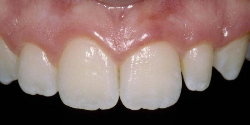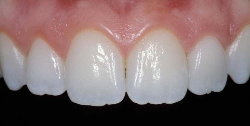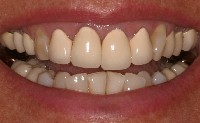A dental crown is used to “cap” a tooth that has broken or has a large cavity that can’t be filled without compromising the stability of the tooth. It covers the the entire visible surface of the tooth to the gumline, protecting the damaged tooth and restoring its function.
Porcelain crowns can also be used to correct an aesthetic deficit, such as a missing or misshapen tooth, as shown in the images below. The patient in these pictures has a “peg lateral”, or a noticeably smaller left lateral incisor. The bottom picture depicts the new dental crown in place over the peg lateral. Notice how it matches the natural teeth exactly in size, color and opacity.


Dental crowns are also commonly used to replace missing teeth. A false tooth or teeth can be suspended between crowns on the adjacent teeth to create a dental bridge. Crowns can also be individually anchored by a dental implant. Visit our pages on dental bridges and implants to read more about how crowns can restore missing teeth.
Today’s Dental Ceramics
Advances in cosmetic dentistry have led to many new materials that can be used to create aesthetic and functional crowns, each with their own benefits and applications.
All-Porcelain Crowns
Thanks to advances in bonding technology, crowns can now be created entirely of porcelain. Expertly crafted porcelain crowns can so closely resemble the color, shape, and translucency of your own teeth that it can be impossible to distinguish the difference. The versatility in optic qualities of porcelain allows the ceramist to perfectly mimic the appearance of your teeth, and makes it one of the most widely preferred materials for anterior crowns.
The pictures below illustrate clearly the dramatic difference between a full set of porcelain-fused-to-metal versus all-porcelain crowns. Notice the dark line at the gumline in the top picture, as well as the jarring difference in opacity between the crowns and the natural teeth. The bottom picture is the same patient with new, all-porcelain crowns in place.

Porcelain Fused to Metal Crowns

All Porcelain Crowns
e.max
Dr. Patel also offers innovative options like e.max crowns, which are made from a sturdier ceramic called lithium disilicate. The stronger foundation means e.max can withstand the heavier chewing pressures of premolars, and a porcelain finish provides optimal aesthetics ideal for anterior teeth.
Porcelain Fused to Zirconia (PFZ)
Zirconia is another strong ceramic that can be used to create a crown on anterior or posterior teeth. In fact, zirconia is even stronger than the natural tooth structure. Porcelain is then fused to the zirconia to match the surrounding teeth. Because the zirconia has a bright white, opaque appearance, a thicker layer of the porcelain is needed to mimic the translucency of your natural tooth. This means that the underlying tooth structure will often need to be slightly more reduced during preparation in order to avoid a bulky appearance in the finished product.
Porcelain Fused to Metal (PFM)
For posterior teeth in some patients with a particularly heavy bite, Dr. Patel may suggest a gold crown with a porcelain veneering. The underlying gold is stronger than an all-porcelain crown, allowing it to withstand the additional pressure applied to the back teeth when chewing, while the fused porcelain gives the crown a more natural appearance. To adequately camouflage the opacity of the gold, however, the porcelain overlay cannot achieve the same translucency of your natural teeth, so PFM crowns are usually not the most aesthetic option to use in the very front of your mouth.
Dr. Patel also offers gold crowns for posterior teeth for the longest lasting restorations. Unlike ceramics, gold will never chip or break, and it can be made to a very precise fit on the tooth. While gold crowns don’t offer the same aesthetics as porcelain crowns, they do allow for superior longevity. Read more on our gold crowns page.
An experienced cosmetic dentist like Dr. Patel will choose the best materials available to suit your needs and give you a strong, beautiful restoration that lasts.
Schedule an appointment
If you’re considering dental crowns, request an appointment online or call our office at (313) 885-9454 to schedule a visit with Dr. Patel to discuss which option is best for you.


